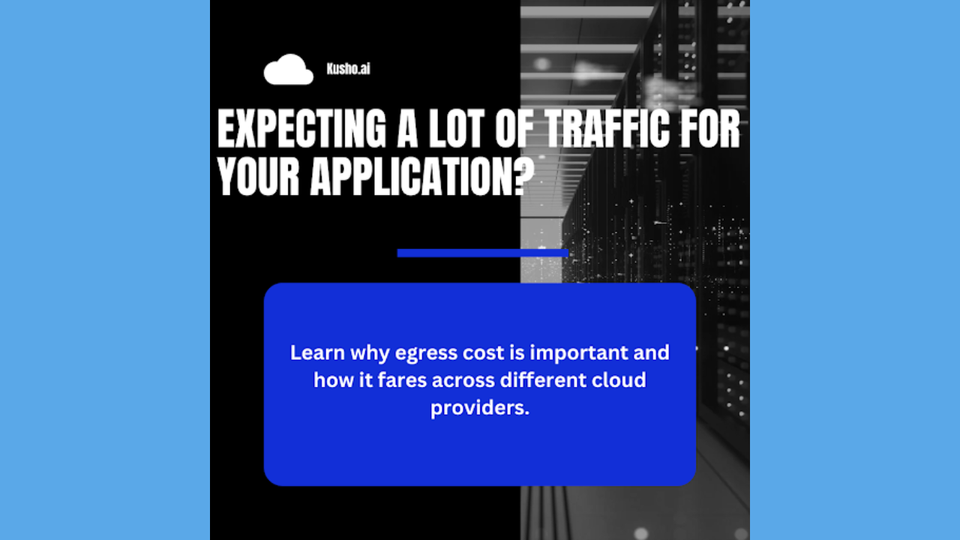Expecting a lot of traffic for your application? Learn why egress cost is important and how it fares across different cloud providers
 Sakshi from KushoAI
Sakshi from KushoAI
This blog is written by Akshat Virmani at KushoAI. We're building the fastest way to test your APIs. It's completely free and you can sign up here.
As cloud-based applications scale and serve more traffic, developers and businesses often focus on ensuring uptime, scaling resources, and optimizing performance. However, one critical factor often overlooked is egress cost—the price you pay for data leaving the cloud provider’s network.
What is Egress Cost?
Egress cost refers to the fees charged by cloud providers to transfer data from a cloud provider to the Internet or another service. This cost is typically calculated by the volume of data being transferred.
For example, if your application serves video files to users, data leaves your cloud service (egress) each time a user streams a video. The more users or larger the files, the higher your egress bill.
Why is Egress Cost Important?
Scalability Considerations: As your user base grows, so will your data outflows. Understanding egress costs helps you plan for future expenses and avoid unwanted surprises when scaling.
Application Performance: Egress costs, in some cases, can influence decisions about where data is stored and how it's delivered to the users. Optimizing for both cost and performance is critical for providing a good user experience.
Cost Management: Egress costs can accumulate quickly, especially for applications or services that handle large amounts of data transfer. Understanding and managing these costs is essential for keeping cloud expenses under control.
Egress Costs Across Cloud Providers
Let’s see how the three major cloud providers—Amazon Web Services (AWS), Google Cloud Platform (GCP), and Microsoft Azure approach egress costs.
1. Amazon Web Services (AWS)
AWS is one of the most popular cloud providers, known for offering flexible pricing. Egress charges depend on the volume of data transferred and its destination.
Up to 10TB: $0.09 per GB.
Beyond 10TB: Lower per-GB rates for higher transfer volumes.
Regional differences: AWS has pricing based on whether data is transferred within the same region or to another AWS region.
Pros:
Offers free egress for small volumes.
Volume discounts for high data transfer usage.
Cons:
- Complexity in regional pricing and tiering.
2. Google Cloud Platform (GCP)
GCP egress costs are similar to AWS, but it offers a few advantages for developers, especially when handling regional traffic.
Up to 10TB: $0.12 per GB.
Beyond 10TB: Discounted rates apply.
Regional differences: Transferring data between GCP services in the same region is usually free.
Pros:
Transparent pricing and easy-to-understand cost structure.
Free egress between GCP services within the same region and other Google platforms.
Cons:
- Higher costs for larger volumes compared to AWS.
3. Microsoft Azure
Azure provides a comparable structure to AWS and GCP, with slight variations in pricing for specific scenarios, such as Content Delivery Networks (CDNs).
Up to 10TB: $0.087 per GB.
Beyond 10TB: Discounted based on volume.
Regional differences: Free data transfer between Azure services in the same region.
Pros:
- Lower pricing for large-scale transfers than GCP.
Cons:
- More complex pricing tiers, especially for international data transfers.
You can find more details on the pricing here:
Amazon Web Services (AWS) Pricing:https://aws.amazon.com/ec2/pricing/on-demand/#Data_Transfer
Google Cloud Platform (GCP) Pricing:https://cloud.google.com/vpc/network-pricing#internet_egress
Microsoft Azure Pricing:https://azure.microsoft.com/en-us/pricing/details/bandwidth/
Factors Affecting Egress Cost
Strategies to Optimize Egress Costs
Leverage CDN: Use a Content Delivery Network (CDN) to cache content closer to users, reducing egress traffic by serving data locally.
Regional Traffic Optimization: Keep data transfers within the same region if possible, as cross-region data transfers often have higher costs.
Monitor Usage: Monitor your application’s data transfer continuously by using the cloud provider’s monitoring tools to avoid sudden cost spikes.
Negotiate with Providers: If you foresee large data transfer volumes, it’s worth negotiating custom pricing agreements with cloud providers.
To Conclude
As traffic to your application increases, so does understanding egress costs. Being aware of how these costs are structured across cloud providers like AWS, GCP, and Azure can help you make informed decisions about managing your data traffic and budget accordingly and ensure your application's scalability.
This blog is written by Akshat Virmani at KushoAI. We're building an AI agent that tests your APIs for you. Bring in API information and watch KushoAI turn it into fully functional and exhaustive test suites in minutes.
Subscribe to my newsletter
Read articles from Sakshi from KushoAI directly inside your inbox. Subscribe to the newsletter, and don't miss out.
Written by